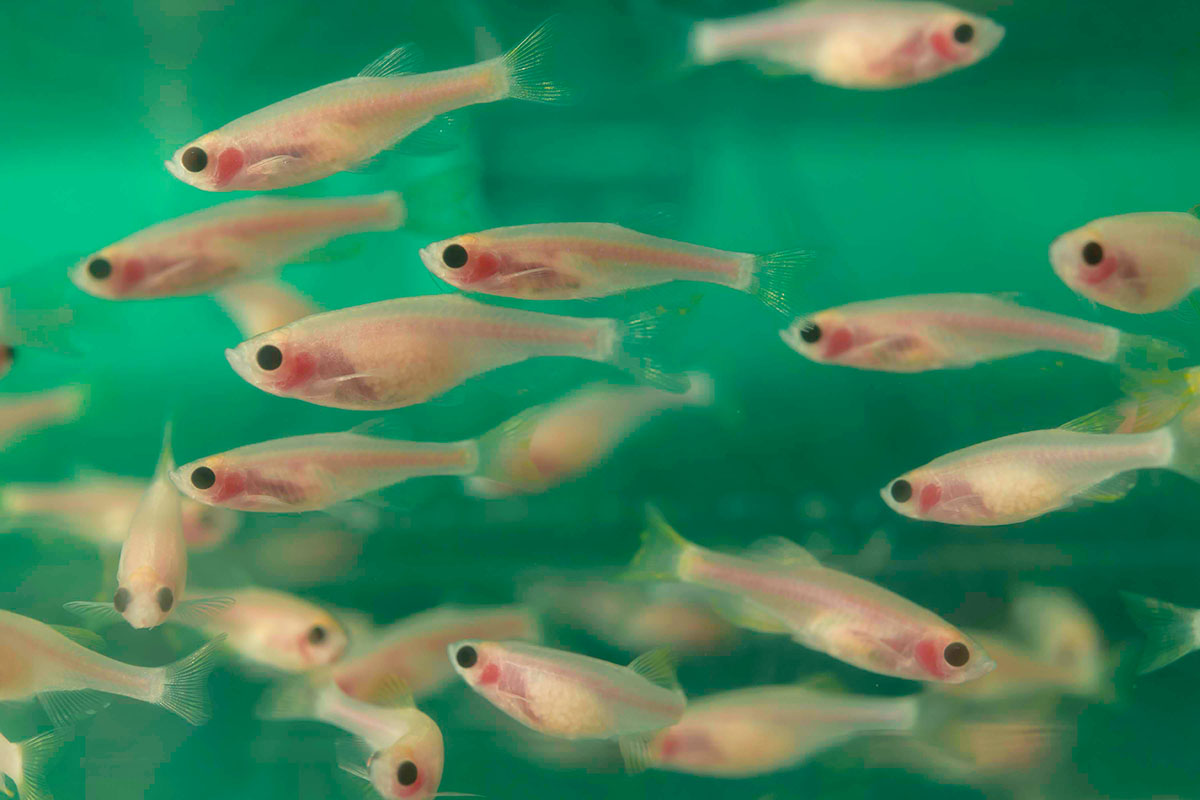
Postdoctoral researcher Yanan Ma, PhD, led a project that investigated a cancer-linked inflammation pathway in zebrafish.
In science, how you ask a question is often as important as what you ask.

Philipp Niethammer, PhD
The lab of cell biologist Philipp Niethammer, PhD, of the Sloan Kettering Institute at Memorial Sloan Kettering Cancer Center (MSK), studies fast-acting mechanisms of inflammation that protect our bodies against infection — but which can cause damage if they run amok. These mechanisms may also play a role in the prevention and development of some cancers.
Under a project led by postdoctoral researcher Yanan Ma, PhD, the lab was particularly interested in understanding an inflammatory lipid called 5-oxoETE. It has rarely been studied because the receptor that the lipid interacts with — OXER1 — isn’t present in rats and mice, which account for about 95% of animals used in laboratory research.
“This means the function of this immune signaling pathway can’t easily be studied using rodents,” Dr. Ma says.
So the lab turned to a lesser-known research model: zebrafish — a small, silvery freshwater fish in the minnow family.
Here, Dr. Ma shares more about the research, which was published in the journal Cell Reports on January 10, 2023, and what it teaches us about inflammation
What questions was your research trying to answer?
Our lab focuses on these inflammatory mechanisms that protect the inner linings of our organs and body cavities — like our mouth and lungs and stomach — against infection, but which can cause damage if they get out of control.
Both beneficial and harmful effects of this inflammation of the mucosal membranes are often caused by the rapid accumulation of a special type of antimicrobial white blood cell, called a neutrophil. We are interested in the molecular mechanisms that guide rapid neutrophil accumulation in tissues, and hope ultimately to harness them for therapeutic benefit.
In this study, we were investigating the physiological role of a poorly understood inflammatory lipid, called 5-oxoETE. It binds to a receptor molecule — OXER1 — on the surface of the neutrophil, which promotes neutrophil migration and accumulation.
Previous evidence suggested 5-oxoETE plays a role in airway inflammation caused by allergic reactions and in neutrophil response to wounds. But its central physiological functions have been elusive, so we set out to understand them better.

Zebrafish swim in a tank at MSK.
While OXER1 is present in humans and in most larger mammals, like cats and monkeys, it is not evolutionarily conserved in mice or rats — which are the most popular animal models for preclinical research. Fish, however, do have this receptor and so make a great model for study.
Intriguingly, OXER1 seems to get turned off by mutations in some cancers. But to make credible predictions about whether or how this might affect the development of cancer, we first need to better understand how OXER1 functions at a more fundamental level. So we set up experiments to study it in a zebrafish model.
What were your findings? And what is the potential relevance to cancer?
When we infected zebrafish ears with a bacteria called Pseudomonas aeruginosa, we found that both 5-oxoETE and OXER1 start to be produced — a sign both are playing a key role in helping the fish fight the infection. (And yes, fish have ears!)
When we manipulated the zebrafish larvae to lack a functional version of OXER1, they frequently succumbed to infection — probably because neutrophils were unable to rally to the infection sites.
Altogether, our studies identified the 5-oxoETE/OXER1 pathway as an important immune pathway.
And since OXER1 gets deactivated in some types of tumors, it may play a role in preventing some cancers — possibly related to OXER1’s role in inflammation and immune surveillance that we demonstrated in our research. We will test this idea in future studies.
What is the significance of your findings?
Identifying 5-oxoETE/OXER1 as an important immune pathway may point us toward new therapeutic approaches.
Additionally, our work stresses an important yet little appreciated strength of zebrafish as a research model. Solely relying on mice or rats, or any single species, to make assumptions about human disease mechanisms can, as a worst-case scenario, mislead or delay preclinical research.
No single animal model is perfect. They all have strengths and weaknesses. In biomedical research — just like in the natural world — diversity matters. Here at the Sloan Kettering Institute, and at MSK more broadly, we maintain a broad portfolio of different species to answer different research questions.
Although the evolutionary distance of humans to fish is, overall, larger than from humans to rodents, the amount of genetic divergence isn’t equally distributed. Some human biology is better conserved in rodents than in fish, and our study highlights how the opposite can also be true. Beyond OXER1, there are about 150 other zebrafish genes that are present in humans that don’t have a clear counterpart in mice or rats.
In other words, there remains a lot of untapped potential to use zebrafish as a tool to illuminate the mechanisms of human disease.